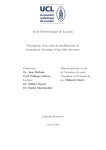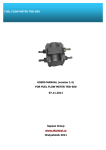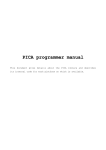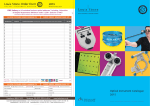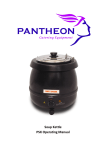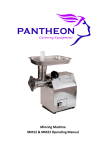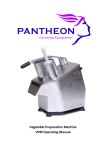Download a visual user interface for the Pantheon storage - e
Transcript
Oculus:
a visual user interface for the
Pantheon storage system
simulator
Uwe Aicheler
Storage Systems Program
Computer Systems Laboratory
Hewlett-Packard Laboratories
HPL–SSP–96–1, January 8, 1996
Approved for External Distribution
Abstract
The Pantheon storage system simulator was built to allow exploration of a range
of design choices in storage systems. Simulations can take several hours or days to
execute and generate a large amount of performance data that is often hard to
interpret. In order to gain more insight into the operation of the simulated system,
we want to see what is happening inside the simulator.
Oculus is an X-window based graphical tool that allows the visualization of the
state and performance of the simulated system during the simulation.
Oculus - Contents
Contents
Contents 4
Figures 5
Tables 5
Introduction 6
Motivation 6
Overview & Goals 6
The remainder of this paper 7
The Pantheon storage system simulator 8
Introduction 8
Simulator overview 9
Tcl as configuration interface 12
Measurement points 13
Short Oculus Manual 14
Starting the simulator with Oculus 14
Selecting Pantheon objects to monitor in Oculus 14
The Oculus Menu 14
Graph windows 16
Analysis & Specification 17
Development process: Rapid Prototyping 17
Oculus Goals 18
General Ideas 18
Structured Analysis 19
Communication Protocol Specification 25
Design 26
Communication Design 26
Pantheon Extensions 27
The Oculus interpreter 28
The Viewer hierarchy 30
The Ctrl hierarchy 31
Names of Ctrls / Ctrl selection 32
Ctrls with C++ Stats objects in Oculus 32
Test Design 34
File Structure 35
Implementation & Validation 37
Source Code reference 37
Test Results 37
4
Oculus - Figures
Development Reviews 38
Important Decisions 38
Enhancement Possibilities 39
How to Extend Oculus 39
Conclusions 40
Acknowledgments 41
References 41
Author information 41
Appendix: Source Code 42
Figures
A simple Pantheon simulation 10
measured and simulated physical disk I/O times for the simulator's disk models. 11
Tcl as glue language (toolkit approach) 12
Stats object as a sensor at a disk; Reporter object converts data 13
Function definition create_OculusCtrl 14
screenshot of Oculus with a stripchart, a histogram and a text-viewer 15
Oculus with the graph configure tool 16
Rapid Prototyping: several cycles of development 17
Dataflow Pantheon - Oculus overview 18
Structured Analysis -Overview 20
Structured Analysis - Pantheon 20
Structured Analysis - Oculus 22
communication design Pantheon - Oculus 26
object oriented [incr Tcl] class definition (simplified) 28
Hierarchy diagram of all Ctrl and Viewer classes 30
Example for 2 Ctrl selections 32
Example for a dataSet list from Stats objects 33
head of method Ctrl_StatsHistogram::dataSet 33
Tables
Description of used signs 19
Pantheon - Oculus initialization protocol 25
5
Oculus - Introduction
1 Introduction
1.1 Motivation
The Pantheon storage system simulator was built to allow exploration of a range of design
choices in storage systems. Simulations can take several hours or days to execute and
generate a large amount of performance data that is often hard to interpret. In order to gain
more insight into the operation of the simulated system, we want to see what is happening
inside the simulator.
Oculus should be an X-window based graphical tool that allows the visualization of the
state and performance of the simulated system during the simulation.
This paper gives an introduction to the Pantheon storage system simulator and describes
the Oculus visual user interface.
Pantheon is a big building in Rome from which the simulator got its name. The roof of this
building, which lets light inside the Pantheon building, is called the Oculus.
1.2 Overview & Goals
The user interface Oculus should be a separate Unix process that is updated by the
Pantheon storage system simulator automatically as soon as Pantheon has calculated new
data. This data should be processed in Oculus and statistical data should be calculated. The
user should be able to choose several viewers like a stripchart1, a histogram or a simple text
window to monitor data. These viewers should then also be updated automatically.
1.
diagram with running time axis
6
Oculus - Introduction
1.3 The remainder of this paper
Chapter 2 gives an introduction to the Pantheon storage system simulator. Important
features to understand the Oculus design are also explained.
If you just want to know how to operate Oculus, read the Short Oculus Manual on page 14
(chapter 3).
Chapters 4, 5 and 6 describe the analysis, specification, design, implementation and test of
Oculus and extensions to the Pantheon simulator.
Design changes and alternatives we discussed during the development cycles are
described in chapter 7 (development reviews). This chapter also has a section about
enhancement possibilities, a reference section that describes how to extend Oculus and a
conclusion section.
7
Oculus - The Pantheon storage system simulator
2 The Pantheon storage system simulator
This chapter gives an introduction and an overview of the Pantheon storage system
simulator which already existed. Important features to understand the Oculus design like
the Tcl configuration interface and measurement points are also explained.
2.1 Introduction
The Pantheon simulator was built to allow exploration of a range of design choices in
storage systems: those hardware and software components of a computer system concerned
with I/O to storage devices such as disks. The primary purposes of the simulator are to
provide a flexible testbed for speeding up the process of experimenting with different
design choices, and to provide performance predictions for designs that have yet to be
built.
The simulated storage systems span a wide range of complexity and sophistication. The
simplest is a host processor connected to a single string of disks through a channel such as
SCSI. At the other, complete parallel system implementations with embedded or separate
parallel I/O systems, such as DataMesh [Wilkes92], can be simulated.
The Pantheon simulator was designed to allow exploring changes in several pieces of
hardware. We are interested both in possible designs and also in emulating hardware with
different performance characteristics. A partial list of hardware elements in the simulator
model includes:
• host processors
• host-host interconnects
• host-storage system interconnect
• processors in the storage system
• internal interconnects inside the storage system
• magnetic disks
• (non-volatile) RAM caches
• disk rotation-position-sensing hardware and spin-synchronization.
Pantheon is used to explore a wide range of software designs. Here is a sampling of the
kind of algorithms and policies to explore:
• request sequencing or scheduling
• parity calculation for RAIDs
• inter- and intra-request concurrency
• block-placement and file system layouts
• data compression
• storage hierarchies
Pantheon is also used to explore the effects of performing these functions at different places
in the storage system — for example, at the host processor or in the I/O system itself.
8
Oculus - The Pantheon storage system simulator
The system designs made possible by the above components can be exercised in the
simulator against real workloads (derived from tracing I/O patterns on existing systems),
or against synthetic workloads generated inside the simulator.
2.2 Simulator overview
This section provides an introduction to the overall approach and architecture of the
simulator.
Implementation
Pantheon is an event driven simulator. It is written in C++, and uses Tcl as a configuration
interface to model a range of possible system configurations. At the time of writing, the
simulator contains about 94k lines of C++ code (170 classes) and 12.5k lines of Tcl.
The Raphael C++ multithreading library [Golding 95b] provides coroutines (classes called
"threads") that represent independent activity centers in the model—in this case, things like
disks and interconnect channels. Virtual (simulated) time in the model is advanced when a
thread determines that it needs to perform some activity (e.g., a disk seek), and calls delay
to indicate that it is busy for the amount of time the activity would take.
The collection of components provided by the simulator is assembled at runtime into a
configuration to be modelled. Thus, the system topology is specified as part of the
simulator’s input (as Tcl script), rather than being completely determined at compile time.
One of the simulator’s initialization activities is to establish the interconnections between
the components, and to set the performance parameters of each of the system components
being modelled.
Development environment
The Pantheon simulator has multiple development trees. There are multiple separate
modules with a separate directory per module (such as Oculus/ ). Libraries are installed
in /lib and executables in /bin.
CVS (Concurrent Version System) is used to allow parallel development.
9
Oculus - The Pantheon storage system simulator
Simulator structure
The simulator is composed of a great many different C++ classes and the components
(modules) that they go to make up.
About the simplest model possible is shown in Figure 1. Even this simple system shows
many of the components of the simulator. Working from the top of the picture downwards,
we can identify the following components:
• Stats (Sensor): Overall statistics about the experiment are collected here.
• Host: an entity that represents a processor where application and system cycles can be
consumed. Workloads run on host; hosts communicate with each other and with the
storage subsystem.
• IOload: a workload task that generates a sequence of requests representing a single
workload (e.g., from a single host process). Each IOload is parameterized by an
IOpattern, or reads and replays a trace file.
• Device driver: represents the portion of the host hardware and software that is used to
communicate with a single (virtual) disk in the storage subsystem.
• Disk channel: a path by which requests and data are communicated between the
device driver and the storage elements (disks, here).
• Disk: a rotating magnetic storage device, including hardware and software for
connecting to the disk channel, buffering data, and a medium on which data is stored.
Stats:
experiment
control and
statistics
gathering
Stats
Host processor
IOloads:
workload
generators
Device driver,
with its I/O
request queue
Disk
channel
Figure 1 A simple Pantheon simulation
10
Oculus - The Pantheon storage system simulator
Statistical details
To increase the accuracy of the numbers, the simulator "warms up" the system by running
its workload for an initial period before taking any measurements. The number of warmup requests that must complete before statistics are accumulated can be specified, as can
the total number of I/O operations that are to be measured. The simulator keeps the
workload at full steam until the last request that is to be measured has completed. Together,
these eliminate start-up and termination effects, and the numbers that the simulator
produces are thus those for the system’s behavior in steady-state.
The simulator initializes all its random number generators from a single seed generator (a
random number generator that emits values used as seeds). This mechanism means that all
the random number generators don’t start out with the same seed value, so (for example)
not all the synthetic workload generators attempt to write to exactly the same block on their
first request. By default, the seed generator is itself initialized with a seed of zero, so that
runs are repeatable. For truly random behavior between runs, the seed generator can
optionally be initialized with a seed derived from the low-order bits of the time-of-day
clock.
Disk timing verification
Some experiments were conducted to compare the model against real disk drives. The
physical I/O times for a week of I/O traces to a set of disks were captured. Then the same
I/O requests were fed into the simulator, and the modelled I/O times were compared
against the real ones. The results are shown in Figure 2 as emulative distribution diagrams
(x-axis: time/ms, y-axis: fraction of I/Os).
As the graph shows, the agreement is quite good. The marginal discrepancy in the
Quantum case is due to the real Quantum disk drive not using immediate reporting for
quite as many requests as the description above would suggest. However, this is a small
discrepancy, and is unlikely to represent a significant difference in overall performance.
1
1
0.9
0.9
0.8
0.8
0.7
0.7
0.6
0.6
0.5
0.5
0.4
0.4
0.3
0.3
0.2
0.2
real
simulated
0.1
real
simulated
0.1
0
0
0
10
20
30
40
50
60
0
70
a. HP97560
10
20
30
40
50
b. Quantum PD425S
Figure 2 measured and simulated physical disk I/O times for the simulator's disk models.
11
60
70
Oculus - The Pantheon storage system simulator
2.3 Tcl as configuration interface
Tcl is an interpretive language that was developed by John Ousterhout at the University of
California at Berkeley. It is implemented as a C library and contains the parser and some
general routines. This library can be integrated in existing C programs to get a mighty
macro or script language. The interpreter can be easily extended with additional
commands to access functions and data of the program.
The following simple Tcl example prints: name2 contains Uwe
set name1 Uwe
set name2 $name1
set text "name2 contains $name2"
puts $text
Pantheon uses Tcl to configure the simulated system [Golding 94]. Each C++ simulation
object class has a function (registered with Tcl as a command of the same name as the class)
that builds a new instance of the class, constructs a unique name for it, and enters this into
a hashed lookup table that maps the text name to a pointer to the new object. (This structure
is very similar in intent to the object table used in SmallTalk interpreters [Goldberg 94]).
Thus:
sensor
set link [Link "SCSI-bus" -b 10e6]
constructs an object to represent a SCSI bus with a bandwidth (-b) of 10MB/s, generates a
name-string for it, and assigns this string to the Tcl variable link. Now this Tcl variable can
be treated just like a C++ pointer to the object itself.
link
10 Mb/s
2M
Tcl
scheduling
policy
FCF
disk
Figure 3 Tcl as glue language (toolkit approach)
12
4300 rpm
3 platters
Oculus - The Pantheon storage system simulator
Execution Flow
The simulator execution flow is as follows:
runPantheon
(shell script)
– generates main Tcl script
– calls Pantheon executable
Pantheon
(C++ program)
– creates Tcl interpreter
– adds C++ interface functions to Tcl interpreter
– executes configuration scripts on interpreter
configuration scripts
(Tcl scripts)
– configure simulation architecture in Pantheon
– call Oculus (optional)
– start the simulation
2.4 Measurement points
Some simulation classes provide measurement points to allow Stats objects to accumulate
data and to calculate statistical data. The measurement point can be a pointer to a Stats
object or null (not present). The Tcl configuration code decides if the measurement point
should be used or not.
The C++ class hierarchy has a number of different Stats objects (Stats, StatsHistogram,
StatsHistogramUniform, StatsHistogramLog, ...) which can be used as a sensor and
calculate simple statistical values (Stats) as well as large data like histograms
(StatsHistogram).
At the end of the simulation, the Stats objects hand their data to a Reporter object, which
collects their current state and stores the data as Tcl scripts. This data can afterwards be
evaluated or used by tools to generate diagrams.
Reporter object
Stats object
3 Mb/s
FCFS
Figure 4 Stats object as a sensor at a disk; Reporter object converts data
13
Oculus - Short Oculus Manual
3 Short Oculus Manual
In order to better understand the design and implementation details of Oculus, it is useful
to first have an overall picture of what Oculus does. In order to provide such an overview,
this section presents a short Oculus user manual.
3.1 Starting the simulator with Oculus
Start the Pantheon simulator with: make test
To start the Pantheon simulator with Oculus, you must specify in the test parameter file
(test.parms):
-O <OculusLevel>
where OculusLevel is the threshold which decides if an object should be monitored or
not. The higher the OculusLevel, the more Stats objects will be monitored, -1 means that
Oculus should not be invoked. This file will be evaluated before the simulation starts.
The following example will invoke Oculus with OculusLevel 1:
-O 1
Make sure that the procedure InitOculus (defined in Pantheon/oculus_proc.tcl)
is called as one of the first commands of the Tcl scripts.
3.2 Selecting Pantheon objects to monitor in Oculus
The objects in Pantheon that should be monitored in Oculus must be specified in a
Pantheon Tcl script. To select an object the Tcl procedure create_OculusCtrl (defined in
Pantheon/oculus_proc.tcl) must be called after the object create command in a Tcl
script. This function creates a Ctrl object in Oculus which controls incoming data and the
Pantheon object is connected to a Reporter that updates are reported.
proc create_OculusCtrl {ObjName ObjOculusLevel stat_cmd} {
#----------------------------------------------------------------------------# Function to monitor an object.
# It tries to register the object on Oculus and
# establishes the connection between Stats and OculusReporter in Pantheon.
# Arguments: ObjName: Pantheon name of the object
#
ObjOculusLevel:Level of the object, if this is higher than the
#
global OculusLevel the Ctrl is not created and
#
the object is not monitored!
# Returns:
1 if it is monitored
# Sideeffects:no
#-----------------------------------------------------------------------------
Figure 5 Function definition create_OculusCtrl
3.3 The Oculus Menu
After Oculus is invoked by Pantheon, a list of the Ctrl‘s will be displayed in the main
window. The user can e.g. mark an item with the mouse and select commands from the
main menu to show a viewer of this object. A viewer is a window that monitors data of an
object.
14
Oculus - Short Oculus Manual
Menu commands
• File - Save Window Positions
Opens a file select window to save (viewers) windows positions to.
• File - Load Window Positions
Opens a file select window to load windows positions from.
• Show - Textwindow
Creates a new text window (viewer) with the data of the selected object in the listbox.
The data can be updated by pressing the "update" button. The text can be selected in
the window and copied to the clipboard with [Ctrl] [Insert].
• Show - Stripchart
Creates a new stripchart viewer with the data of the selected object in the listbox. The
display is updated automatically. This command is only available if the selected
object supports a histogram.
• Show - Histogram
Creates a new histogram viewer with the data of the selected object in the listbox. The
display is updated automatically. This command is only available if the selected
object supports a histogram.
• Help
Shows information about Oculus.
Figure 6 screenshot of Oculus with a stripchart, a histogram and a text-viewer
15
Oculus - Short Oculus Manual
3.4 Graph windows
Graph windows like stripchart and histogram provide special features:
• configure
Opens the graph configure application (which was copied from a demo of the BLT
widget library). This application lets you configure the diagram, elements, axis,
legend, crosshairs and the Postscript options of the graph widget.
• postscript
Generates a postscript file of the diagram.
• update
This button updates the diagram immediately. The diagram is usually updated
automatically on every 5 data updates for the stripchart and every 20 data updates
for the histogram. (This can be changed by altering the update_interval variable
of the according class.)
• zooming
You can use your mouse to zoom the diagram by pressing the left mouse button and
dragging the mouse over the interesting area. The diagram is repainted with the new
scope/scale when you release the mouse button. If you press the left mouse button
beside the graph area, the diagram will be repainted with the original scope.
• active legend
When you move your mouse over an item of the legend the according curve in the
graph will be highlighted.
Figure 7 Oculus with the graph configure tool
16
Oculus - Analysis & Specification
4 Analysis & Specification
This chapter describes the Rapid Prototyping software development process and the
analysis and specification of Oculus.
To make the analysis, specification, design, implementation and test of Oculus easy to
understand, this and the following chapters describe the last development cycle of the
Rapid Prototyping process. If you are interested in important decisions and alternatives we
discussed during the development, read section: Important Decisions on page 38.
4.1 Development process: Rapid Prototyping
Because Oculus will be used as a tool to help us evaluate I/O experiments, it will evolve to
include new functionality as we use it and discover how it can be improved. The Phase
Review software process, which is quite rigid, is not well adapted to the development of
this kind of tool.
Instead, we use an iterative development process (also called Rapid Prototyping or spiral
design model) where some basic features are specified, designed, implemented and tested,
and then the design is refined and additional features are added iteratively. This method is
very commonly used in the software industry.
The process is like a spiral moving through the 4 fields analysis, design, implementation
and test beginning from the inside (analysis) and ending at the outside (test) field in several
cycles.
design
analysis &
specification
implementation
test
Figure 8 Rapid Prototyping: several cycles of development
17
Oculus - Analysis & Specification
4.2 Oculus Goals
The goals for the Oculus user interface are defined as follows:
• Monitoring of Pantheon Stats objects during simulation
The data of statistical objects should be displayed during the simulation and not only
after the simulation is finished.
• Pantheon not slower when Oculus not used
Pantheon should not lose any performance because of changes if Oculus is not used.
• Active user interface
Oculus should not be a "dead" application where the user cannot interact during the
simulation. Instead, the user should be able to perform actions like changing viewers.
• Different charts / viewers
The user should have a choice of different ways to visualize the data.
• Flexible and extensible architecture
The design of Oculus should be as flexible as possible to make it easy to extend or to
make changes to Oculus.
• Easy to use
This is a goal of every user interface.
4.3 General Ideas
Oculus is a separate Unix process and receives its data from the Pantheon simulator
process.
Pantheon
Stats
Oculus
Reporter
Figure 9 Dataflow Pantheon - Oculus overview
The basic idea is to use the Stats objects (that are already used in Pantheon as a sensor and
for statistical calculation) and connect them to a special Reporter ("OculusReporter").
The difference is that they should send updates to the Reporter immediately after they
receive an update. The Reporter then sends the data through a communication channel to
Oculus.
On the Oculus side one Ctrl object exists for every Stats object on Pantheon that should be
monitored. The Ctrl objects process the incoming data and handle the viewer windows.
The fact that a Pantheon object "should be monitored" doesn‘t mean that its data is always
displayed in a viewer on the screen. It just means that the corresponding Ctrl object in
Oculus is updated and the user can choose a viewer to see the data.
18
Oculus - Analysis & Specification
4.4 Structured Analysis
This section shows the Oculus analysis with the help of Tom De Macro’s Structured
Analysis (SA) and Real-Time Modeling of Hetley/Pirbhai. This technique is extended here
by the control & data flow, which combines both control and data within one arrow. In the
data dictionary the control specification appears as the arrow’s name. The data
specification appears with the same name plus the suffix "_data". There can be more SA
processes (objects) of the same process type (class). Those are indexed with 1, 2, 3 in the
figures.
If you don’t know Structured Analysis: please note that the Structured Analysis processes
don’t need to be Unix processes or tasks or threads! SA processes are centers of activity in
the system.
This section is also useful because every SA process with a name that ends with "_object" is
represented as an object in the design. Those figures show how the objects are designed to
glue together.
Table 1 Description of used signs
data flow
control flow
control & data flow
process, action
(please note that a Structured Analysis process doesn’t need to be a real
Unix process or a separate task)
source or destination for control or data flows
19
Oculus - Analysis & Specification
Overview
user
start_Pantheon
user_command
sim_config
start_Oculus
create_Ctrl
Pantheon
Oculus
Oculus_update
Figure 10 Structured Analysis -Overview
Pantheon
start_Pantheon
sim_config
Stats_update1
Stats_
object1
Stats_
object2
simulator_
engine
Stats_
object3
start_Oculus
create_Ctrl
Figure 11 Structured Analysis - Pantheon
20
Reporter_update1
Oculus_
Reporter_
object
Oculus_update
Oculus - Analysis & Specification
Process specifications:
process name:
simulator_engine
input:
sim_config (data), start_Pantheon (control)
output:
start_Oculus (control), create_Ctrl (control & data),
Stats_update1 (control & data)
body:
The simulatior_engine represents the simulator core with the simulated system. It
is not detailed further, because the subprocesses are not important to understand
Oculus. The sim_config input flow specifies the simulation configuration given by
the user, who can start the simulation with the control flow start_Pantheon.
Start_Pantheon will activate the necessary subprocesses which send updates
through the Stats_update control and data flows to the Stats_object SA
processes.
process name:
Stats_object
input:
Stats_update (control & data)
output:
Reporter_update (control & data)
body:
This process (object) receives statistical data for one measurement point through the
Stats_update control & data flow. The data is sent directly to the
Oculus_Reporter_object through the Reporter_update flows.
process name:
Oculus_Reporter_object
input:
Reporter_update (control & data)
output:
Oculus_update (control & data)
body:
This SA process (object) updates Oculus. It gets the data from the Reporter_update
flow, converts the format and sends the data through the Oculus_update control &
data flow to Oculus.
21
Oculus - Analysis & Specification
Oculus
user_command
Ctrl_update1
Ctrl_
object1
Viewer_
object1
Viewer_update1
start_Oculus
Ctrl_
object2
Viewer_
object2
Ctrl_
object3
Viewer_
object3
Oculus_
controller
create_Ctrl
Oculus_update
Figure 12 Structured Analysis - Oculus
Process specifications:
process name:
Oculus_controller
input:
start_Oculus (control), create_Ctrl (control & data),
Oculus_update (control & data), user_command (control)
output:
Ctrl_update (control & data)
body:
Oculus_controller represents the Oculus main window and the Oculus core which
processes incoming commands from Pantheon and X-Window events
(user_command control flow). Incoming control & data flows (commands) from
Pantheon can be create_Ctrl which should create Ctrls in Oculus, or
Oculus_update with new data. The start_Oculus control flow displays the main
window and activates all subprocesses.
22
Oculus - Analysis & Specification
process name:
Ctrl_object
input:
Ctrl_update (control & data)
output:
Viewer_update (control & data)
body:
A Ctrl_object can be a parent objects for no, one or more Viewer_objects. This
process gets new values through the Ctrl_update control & data flow to store and
to calculate of statistical data. This data will then be sent through the
Viewer_update control & data flow to existing Viewer_objects to be displayed
on the screen.
process name:
Viewer_object
input:
Viewer_update (control & data)
output:
body:
This process receives its data from Viewer_update control & data flow and visualizes
it on the screen in some way. Different viewers exist for different charts.
23
Oculus - Analysis & Specification
Data dictionary
Ctrl_update
(control flow)
update or no_update
Ctrl_update_data
(data flow)
time + value
Oculus_update
(control flow)
update or no_update
Oculus_update_data
(data flow)
ObjName + time + value
Reporter_update
(control flow)
update or no_update
Reporter_update_data
(data flow)
ObjName + time + value
Stats_update
(control flow)
update or no_update
Stats_update_data
(data flow)
time + value
Viewer_update
(control flow)
update or no_update
Viewer_update_data
(data flow)
data format which is accepted by the various viewers
(can be a list of data points or histogram data)
create_Ctrl
(control flow)
1 or 0
create_Ctrl_data
(data flow)
ObjName + args
(args depend on the class of the object; normally this is
the Tcl command to create the same C++ object as the
Pantheon object)
sim_config
(data flow)
whole configuration of the experiment
(this is too large to explain here)
start_Oculus
(control flow)
1 or 0
start_Pantheon
(control flow)
1 or 0
user_command
(control flow)
mark_list or show_stripchart or
show_histogram or show_textwindow or other
new commands
24
Oculus - Analysis & Specification
4.5 Communication Protocol Specification
Since Oculus is a separate process, a communication protocol needs to be specified so that
Pantheon can create Ctrls in Oculus and send updates to Oculus. Table 2 shows the
initalization steps.
Table 2 Pantheon - Oculus initialization protocol
Pantheon
invokes Oculus and establishes the communication channel
Oculus
creates the main window
Pantheon
interprets Tcl scripts and sends OculusCreateCtrl <name>
Oculus
creates a Ctrl object and
updates the List of Stats in main window
Pantheon
starts the simulation and
sends data updates to Oculus
To create a Ctrl on the Oculus side the following command must be sent to Oculus:
OculusCreateCtrl <ObjName>
|
|
|
|
|
|
|
----e.g.
|
--- Tcl procedure
<args>
|
----e.g. initialization arguments
":Stats:3:disk0.0.length_reads:"
The ObjName must be a unique name and the type (class) of the object must appear
between the first two colons!
To send data to Oculus the following command must be sent to Oculus:
dataSet <ObjName> <DataList>
|
|
|
----e.g. ":Stats:3:disk0.0.length_reads:"
|
--- Tcl procedure
where the following is an example of the format of DataList.
(This format can be evaluated as a Tcl-list on the Oculus interpreter.)
{ { value 1537 } { mean 5302.55 } }
25
Oculus - Design
5 Design
This chapter describes the design of the overall project.
5.1 Communication Design
Figure 13 shows the asynchronous communication channel from Pantheon to Oculus. To
make the channel accessible in Pantheon from the C++ scope as well as from the Tcl scope,
a Unix pipe is used where Pantheon can send out commands with data. Another advantage
of a pipe is that the Pantheon simulator doesn‘t block because of something like a remote
procedure call.
To avoid blocking on the Oculus side the commands that are piped out from Pantheon are
invoked with the Tk-send command on the Oculus interpreter. Tk-send can be called
within a Tcl/Tk script with a name of another running Tk-interpreter and a command as
arguments. The command will then be invoked on the specified interpreter as if this
command would be called within the script of that program. Thus, X-events can be
processed in Oculus without waiting or polling for an incoming Pantheon command.
The connect process
To meet both requirements an additional process (Tk-script) handles the communication in
a way that both processes can run at the same time. After the simulation is started Pantheon
will invoke connect and connect will invoke Oculus. The commands from the pipe are
invoked on the Oculus side with the Tk-send command. They should be separated by 2
newlines in the pipe.
As an option Pantheon can send RPC as a prefix with the command to wait for a result of
Oculus. The result (result of the Tk-send command) will be sent back to the pipe again.
Because there‘s no need to get a result yet, this option is not used.
Oculus
Pantheon
C++
e
pip
connect.tcl
d
Tcl
n
-se
Tk
Figure 13 communication design Pantheon - Oculus
26
command
invoked
on interpreter
Oculus - Design
5.2 Pantheon Extensions
The Tcl interface
Some additional Tcl procedures allow Tcl to invoke Oculus, to establish the connection and
to send commands (with data) to Oculus. These procedures can be accessed from the Tcl
scope as well as from the C++ scope (by invoking Tcl_Eval(...) which is a service
function of the Tcl C library). For better performance, the Oculus pipe identifier can be
handed to the C++ scope to output directly to the pipe.
If the user interface is switched on, a global OculusReporter object is created from the Tcl
scope; all Stats objects will be attached to the OculusReporter if they should be monitored
(see Structured Analysis on page 19). OculusReporter is an instance of the C++ class
ReporterTCL and handles the data conversion and output to the pipe for Oculus.
C++ extensions
The Stats objects are extended with a pointer to OculusReporter. This pointer also serves as
a flag: NULL means that the Stats should not be monitored. Whenever the Stats object is
updated (when its add() method is called) and the object should be monitored, time and
value will be passed to the OculusReporter to keep the corresponding Ctrl on the Oculus
side up-to-date.
The Stats objects to monitor are selected during the build-up phase of the simulator. The Tcl
procedure create_OculusCtrl {ObjName ObjOculusLevel stat_cmd} can be
used (defined in Pantheon/oculus_proc.tcl). Actions of create_OculusCtrl are:
• If the ObjOculusLevel (given as parameter) is higher than the global
OculusLevel1 the object will not be monitored and the function returns with 0. If
not the function ...
• sends the command OculusCreateCtrl to the Oculus pipe and ...
• establishes the link between Stats and OculusReporter in Pantheon.
The sequence of a data update is the following:
• If the Stats object is updated during the simulation and the OculusReporter
pointer of the object is not NULL, time and value will be handed to the
OculusReporter.
• OculusReporter will pipe out the Tcl command with the data to the connect
process.
• This process invokes the command via Tk-send on the Oculus interpreter, which
causes the update on the Oculus side.
1.
described in: Starting the simulator with Oculus on page 14
27
Oculus - Design
5.3 The Oculus interpreter
The Oculus design should be as flexible as possible to simplify making extensions and the
code should be as reusable as possible. Therefore a powerful language is needed to
implement Oculus. The following packages are combined to one Oculus Tcl interpreter:
• Tcl
Tcl is an interpretive language which was developed by John Ousterhout at the
University of Berkeley. For a short introduction read section: Tcl as configuration
interface on page 12.
• Tk
Tk is a standard Tcl extension for X-windows user interfaces.
• BLT
BLT is an extension which adds graph and diagram widgets to Tk.
• [incr Tcl]
A better name would be Tcl++. This package adds object oriented features to the Tcl
language. Figure 14 shows a simple example.
• Pantheon Stats objects
Since the Pantheon statistical objects (Stats objects) already have a Tcl interface, they
are also added to the interpreter to use them for the calculation of statistical data and
to store data.
itcl_class Ctrl_Base_abstract {
protected name ""
protected TextWin
constructor {name_in args config} {
set name $name_in
set TextWin [Viewer_TextWin #auto $name]
}
# create text window
method update_TextWin {} {
$TextWin update [eval virtual GetData]
}
# show data in text window
method GetData {} {
puts stderr "abstract function called!"
}
# abstract function
}
Figure 14 object oriented [incr Tcl] class definition (simplified)
28
Oculus - Design
How to integrate new libraries to the Tcl interpreter
The interpreter is implemented in the Oculus/oculus_interp.C file. If you want to add
a new package to the interpreter, follow the instructions of its documentation. Usually you
have to include a header file and add a call to the XXX_Init function of this package in the
function Tcl_AppInit(Tcl_Interp *interp) in file Oculus/oculus_interp.C.
To get news about Tcl/Tk packages look at the comp.lang.tcl Internet newsgroup.
The creator of the [incr Tcl] package is Michael J. McLennan1 who is expected to release a
new version soon. He will be collaborating in future with Dean Sheehan who offers another
object oriented Tcl extension called ObjectTcl2.
Exchanging the Tk package
If you want to exchange the Tk package please note that the main() function is within this
library. This insures that the initialization of X-windows and the processing of the
arguments is done right. Within the main() function of Tk the external function
Tcl_AppInit(Tcl_Interp *interp) is called. This function is defined in our file
Oculus/oculus_interp.C and extends the interpreter with our packages.
Since the main() function is in another library a call to _main() has to be placed as the
first command of the main() function in the Tk library. This requires the C++ compiler.
Therefore the tk-3.6.1 directory was modified and copied to:
/usr/local/src/tk/tk-3.6.1_C++/
This directory contains the following changes:
• The command _main(argc, argv) was added as the first statement of the main()
function in file tkMain.c to make the library accessible for C++.
• The Makefile was modified that the new library is called libtk_C++.a and that only
the library is installed.
1.
2.
email: [email protected]
Object Tcl home page: http://www.sco.com/Products/vtcl/objectcl/cover.html
29
Oculus - Design
5.4 The Viewer hierarchy
Figure 15 shows a hierarchy diagram of all Viewer and all Ctrl classes.
Viewers are classes which represent windows on the screen to visualize data in some way.
Each Viewer object is has a Ctrl as a parent object which controls it.
• Viewer_abstract is the abstract base class for all Viewer classes.
Functionality:
- building, packing and binding the toplevel window
- providing a toolbar for optional buttons
- ability to save and load window positions
> If you want to implement a new Viewer class, inherit from this base class.
• Viewer_TextWin represents a window to display data as text. The data can be
updated by pressing the "update" button.
• Viewer_Graph_abstract is an abstract class that contains and handles a graph widget
from the BLT library. Buttons exist to update and to configure the graph and to
generate a Postscript file. Generating a Postscript file and zooming with the mouse
are features of the graph widget so that there is no need to do this work from scratch.
To configure the graph the Graph Config1 application is invoked with the names of
the interpreter and the graph widget as parameters. With the help of this information
Graph Config can send commands directly to the widget to configure it.
> Inherit from this class if your new Viewer class should contain a graph widget.
• Viewer_Stripchart adds a stripchart to the father class to monitor value and mean
over time.
• Viewer_Histogram adds a histogram chart to the father class.
Ctrl hierarchy
Viewer hierarchy
Viewer_abstract
Ctrl_Base_abstract
Viewer_TextWin
Ctrl
C++
Viewer_Graph_abstract
Ctrl_C_object_abstract
Viewer_Stripchart
Ctrl_Stats
Ctrl_StatsHistogram
Viewer_Histogram
Ctrl_StatsHistogramLog
Figure 15 Hierarchy diagram of all Ctrl and Viewer classes
1.
Graph Config was copied from a demonstration application of the BLT package
30
Oculus - Design
5.5 The Ctrl hierarchy
Objects of this type are used to control data and Viewer objects. Each Ctrl handles data from
an object on the Pantheon side that should be monitored. A Ctrl may contain several
pointers to Viewer objects where its data can be visualized. Those pointers are represented
as arrows in Figure 15 and they are also inherited. If you want to see how Ctrls and Viewers
are glued together, look at Figure 12 on page 22.
Description of the Ctrl classes (see hierarchy diagram on the previous page):
• Ctrl_Base_abstract is the abstract base class for all Ctrl classes. It provides general
functionality to receive data and to show it in a Viewer_TextWin window.
> If you want to implement a new Ctrl class, inherit from this class.
• Ctrl is a simple usable class to display data in a text window. It is used whenever
Oculus doesn't find a more specific class.
• Ctrl_C_object_abstract has basic functionality to use a C++ class for processing
data.It simply "duplicates" the same class existing on Pantheon. This reduces the data
transfer, because only data without a lot of statistical data (like e.g. histogram data) is
transferred. That’s why the system is faster even if some statistical data is calculated
twice.
> Inherit from this class if your new class should have a C++ object (like a Stats object)
to calculate or to store data.
• Ctrl_Stats uses a Stats object to calculate and store statistical values that can be
displayed in a text window. It also keeps data lists of the data with a constant number
of entries. This Ctrl can handle a text window (derived from the base class) and a
stripchart window.
> If the new Ctrl should monitor one of the Pantheon Stats hierarchy classes, inherit
from the equivalent Ctrl_Stats class of this hierarchy.
• Ctrl_StatsHistogram uses a StatsHistogram C++ object which keeps histogram data
inside. This data will be displayed in a Viewer_Histogram window. This Ctrl can
handle a text window, a stripchart window and a histogram window.
• Ctrl_StatsHistogramLog uses a StatsHistogramLog C++ object (created by a father
class) which keeps a histogram with logarithmically scaled bins inside. This data will
be displayed in a Viewer_HistogramLog window with a logarithmic scale.
31
Oculus - Design
5.6 Names of Ctrls / Ctrl selection
Ctrl classes to monitor the data of a Pantheon object have the same name as the Pantheon
object with "Ctrl_" as suffix. This makes the selection of the right Ctrl class a lot more easier
when a OculusCreateCtrl <ObjName> <args> command arrives because the
ObjName parameter contains the name of the Pantheon class.
The Ctrl selection algorithm can now simply add "Ctrl_" to the beginning of the ObjName
and cut characters from the end until a class with the same name is found ([incr Tcl] has a
function to find out if a class exists). This class will then be the most specific class and that’s
what we want. If a special Ctrl for a Pantheon object doesn‘t exist, the simplest class "Ctrl"
will be selected to show at least a text window of the incoming data.
Pantheon object name:StatsHistogramUniform
XXX
selection algorithm:StatsHistogramUniform
Ctrl_StatsHistogramUniform
Ctrl_StatsHistogramUnifor
Ctrl_StatsHistogramUnifo
Ctrl_StatsHistogramUnif
Ctrl_StatsHistogramUni
Ctrl_StatsHistogramUn
Ctrl_StatsHistogramU
Ctrl_StatsHistogram
XXX
Ctrl_XXX
Ctrl_XX
Ctrl_X
Ctrl_
Ctrl
Oculus Ctrl name:Ctrl_StatsHistogram
Ctrl
Figure 16 Example for 2 Ctrl selections
5.7 Ctrls with C++ Stats objects in Oculus
All classes derived from Ctrl_C_object_abstract have a pointer to a C++ object (usually an
equivalent to the Pantheon object where the data is coming from).
When the object in Pantheon is updated, the corresponding object in Oculus will be
updated as well. Due to that architecture, Oculus doesn't have to request a lot of data from
Pantheon for example for updating a histogram viewer. (A histogram can contain
thousands of data bins!)
The data transfer between Ctrls and their C++ classes (Stats) in Oculus
Adding data to a Stats objects is very simple. All Stats objects have the same add() function
where one value can be added and the Stats object will calculate the statistical values.
To get the statistical data out of the various Stats objects is a little bit trickier, because each
class calculates (a lot) of different data. This problem was solved connecting the Stats with
a global object of class ReporterTCL (GlobalReporter) which writes the converted data
to a global pipe (ReporterPipe) in Oculus. Please note that this Reporter and this pipe is
not the same that are used within Pantheon, although they are used for the same purpose.
32
Oculus - Design
The member function Stats::report(Reporter *gr, const int detail) hands
statistical data to a Reporter specified as a parameter. The detail parameter describes the
level of detail and can be used to add or leave out more detailed data.
The GlobalReporter handles the data conversion and output from a Stats object to
ReporterPipe. The incoming data (like string, integers, reals, arrays, ...) are converted to
a uniform Tcl command with a structured Tcl list holding the data. This command can then
be read from ReporterPipe and the data string can be evaluated.
dataSet :Stats:2:disk0.0.totalTime_writes: {
{ count 4 }
{ total 0.0966072 }
{ mean 0.0241518 }
{ stddev 0.000405041 }
{ var 1.64058E-07 }
{ 95%conf 0.00039694 }
{ rel95%conf 0.0164352 }
{ min 0.0237106 }
{ max 0.024556 } }
Figure 17 Example for a dataSet list from Stats objects
A smarter way to evaluate the data string is to directly invoke the command on the
interpreter and let it do the work for us. The only thing to do is to provide a local virtual
dataSet method for each class with a data list as an argument. Thus, the virtual dataSet
method of the class (or any of a more specific class) will be invoked to process the data. This
method can then simply access the variables in the data list without having to parse the
hole string.
method dataSet {ObjNameDummy data} {
#-------------------------------------------------------------------------# This method within the method update_Histogram (even if you see no call)
# The trick is explained within the method update_Histogram.
# Arguments:ObjNameDummynot used
#
data
data to evaluate
# Returns:no
# Sideeffects:no
#-------------------------------------------------------------------------# generates variables included in the list
foreach element $data {
set [lindex $element 0] [lindex $element 1]
# e.g. set mean 0.0241518
}
...
# now we can access the list elements as local variables!
Figure 18 head of method Ctrl_StatsHistogram::dataSet
Data flow from a Stats object to its parent Ctrl within Oculus:
Stats C++ object --> GlobalReporter--> ReporterPipe--> Ctrl_XXX.dataSet proc.
33
Oculus - Design
5.8 Test Design
Oculus interpreter tests
To test the interpreter there is a file test_interp.tcl which tests some Tk commands
and the interface to the C++ Stats classes. During the test the file test_interp.tcl is
opened and used for data input for the Stats classes.
Oculus functional, stress and regression tests
The Tcl script test_oculus.tcl can "simulate the simulator" to test Oculus. It contains
procedures for:
• functional tests (There are functional tests for each Ctrl class which create a new Ctrl
within Oculus and update it.)
• stress tests (This test creates a large number of Ctrls and performs a lot of updates.)
• regression tests (This test calls all functional tests to verify that everything still works
after a change or extension.)
The tests have to be defined in the selection section of the same file. You can run all tests
with the communication channel or as a stand-alone version by setting the variable
OclusStandalone in file test_oculus.tcl. If it is 0, Oculus will be tested under real
conditions with the connect process. If it is 1, the Oculus files will be sourced and the
commands (to send) will just be invoked on the interpreter. This is also a way to test the
communication channel.
34
Oculus - Design
5.9 File Structure
The Oculus interpreter
• Oculus/oculus_interp.C
The Oculus interpreter C++ program
• Oculus/Makefile
Makefile for oculs_interp.C
Oculus interpreter tests
• Oculus/test_interp.tcl
This script tests several features of the interpreter
• Oculus/test_interp.dat
This file contains data to be evaluated by the test_interp.tcl script
Oculus program
• Oculus/oculus.tcl
The main file of the Oculus program. This file sources (includes) the following
modules:
• Oculus/mainwin
Procedures for the Oculus main window.
• Oculus/interface.tcl
Interface functions to Pantheon: Those functions will be invoked from outside!
• Oculus/misc.tcl
Miscellaneous procedures for Oculus.
• Oculus/ctrl.tcl
This file contains the Ctrl class hierarchy. Objects of this types are used to control data
and Viewer objects. Each object represents an object on the Pantheon side that should
be monitored. An object may contain several pointers to Viewer objects where its data
is visualized. The Ctrl classes are explained in section Design - The Ctrl hierarchy.
• Oculus/viewer.tcl
This file contains the Viewer hierarchy. Viewers visualize data in a window in some
way. The Viewer classes are explained in section Design - The Viewer hierarchy.
• Pantheon/oculus_share.tcl
This is a "shared library" used by Pantheon and Oculus. Please be very careful when
modifying this file because both applications use it!
• Oculus/features.tcl
These procedures provide additional functionality for graph widgets such as
zooming, active legend, etc.
• Oculus/xftools.tcl
Other procedures copied from the XF Tcl package.
35
Oculus - Design
Oculus tests
• Oculus/test_oculus.tcl
This file contains functional, stress and regression tests for Oculus. It can "simulate
the simulator".
• Oculus/test_interface.tcl
Interface procedures to test Oculus with the communication channel or without (as a
stand-alone version).
The connect process
• Oculus/connect.tcl
Script for the communication channel between Pantheon and Oculus.
Pantheon extensions
• Pantheon/oculus_proc.tcl
Service procedures that have to do with the Oculus interface.
• Pantheon/oculus_share.tcl
This is a "shared library" used by Pantheon and Oculus. Please be very careful when
modifying this file because both applications use it!
• Lintel/Stats... (all Stats C++ hierarchy files)
This files contain the whole Stats hierarchy with classes like Stats (calculates simple
statistical values), StatsHistogram (calculates also histogram data, abstract),
StatsHistogramUniform (with uniform scaled bins), StatsHistogramLog (with
logarithmically scaled bins), etc. Those classes were extended by the ability to send
immediate updates and by a Tcl interface for some methods.
other files:
• Oculus/pipe.tcl
This script is used by the procedure CreatePipe to emulate an internal pipe. This
procedure should once be replaced by a Tcl interface to the C command to create a real
and faster pipe.
36
Oculus - Implementation & Validation
6 Implementation & Validation
6.1 Source Code reference
Each module has a module header with information about:
– the file name
– RCS (Revision Control System) information
– the contents / description
– the author
– the creation data and the last modification date
– the language of the module
– the package and
– the status
Each function has a comment with:
– the description
– the arguments (if exists)
– the return value (if exists)
– side effects
Each class has a comment with:
– the functionality
– abstract procedures
6.2 Test Results
Oculus passed all functional and regression tests. In a stress test 8000 Ctrls were created
with altogether 394940 data updates without problems.
I performed one performance test where the simulation was 15 times slower with 10 Ctrls
and another with 50 Ctrls where it took 33 times longer as opposed to a simulation without
Oculus. This shows that the performance overhead of Oculus is very high, but can be
limited by displaying only a small number of Stats. Note, however, that the simulator is not
slowed down when Oculus is not used, which was one of the goals. Time was too short to
make a good time analysis but the fact that every data update of Stats which should be
monitored is reported to Oculus is certainly a reason. Other critical parts might be the
connect process and the data lists that are kept within Ctrl_Stats because this code is
interpreted.
37
Oculus - Development Reviews
7 Development Reviews
7.1 Important Decisions
This section describes alternatives we discussed and important decisions.
Oculus was developed in 3 Rapid Prototyping1 development cycles. Each design phase
was followed by a design review meeting and each implementation phase was followed by
a code review meeting.
The first experiments were done with a synchronous communication channel. Pantheon
would send data by invoking a Tcl procedure which would wait until the data was
processed by Oculus. This could have been a way to pass back results or even commands
to invoke on the Pantheon interpreter from Oculus, but it turned out to be to slow.
Another idea was to use a separate back channel from Oculus to Pantheon where data
requests or other commands could be submitted. Since we didn’t see an absolute need to
pass back commands for the first version of Oculus this was considered low priority.
Since Ctrl_Stats need to receive each data point (in case that the user wants to see a
stripchart) it did not make sense to transfer all histogram data for histogram viewers on
every display update. Instead, the Ctrl_Histogram (derived from Ctrl_Stats) can be
intelligent and calculate the histogram itself using the equivalent StatsHistogram C++
object existing on the Pantheon side. The advantages are less data transfer because just data
points are submitted and immediate data availability on Oculus. The communication
protocol is also simpler. Thus, we decided to link the Stats C++ interface to the Tcl
interpreter.
What makes the Oculus language very powerful is the object oriented extension package
[incr Tcl]. With the help of this extension the global name space is avoided and the code is
much more modular and flexible.
1.
see: Development process: Rapid Prototyping on page 17
38
Oculus - Development Reviews
7.2 Enhancement Possibilities
The best way to find out what should be changed or added is to use the simulator with
Oculus for a longer period. I couldn’t do that, but anyway here is a list of possible
improvements from my point of view:
• More Viewer and Ctrl classes
Add additional Viewer and Ctrl classes for other objects like the rest of the Stats
objects or for example a viewer to show a cache map.
• Back channel from Pantheon to Oculus
As Oculus becomes more and more active, a back channel to Pantheon will be useful.
There are a lot of possible features which could be added when such a channel is
established. For example one could select an object to monitor which was not
intended to be monitored before. Or other commands could be invoked on the
Pantheon interpreter during simulation.
• Replace the CreatePipe command
In file misc.tcl there is a command "CreatePipe" that returns an emulated internal
pipe by invoking the pipe.tcl script which simply gets and puts strings from stdin
to stdout. This command is used to read the Stats object data from the
GlobalReporter within Oculus. However this is no real Unix pipe and it might be
much faster replace the CreatePipe procedure by a Tcl interface to the real C pipe
command. Unfortunately time was too short to implement and test this.
• Stop/continue button
A nice feature would be a button to stop and continue the simulation.
• New menu commands
Additional menu commands might be comfortable, for example a menu item to
remove all viewer windows.
7.3 How to Extend Oculus
If you want to implement a new Viewer, read section: The Viewer hierarchy on page 30.
If you want to create a new Ctrl class, read section: The Ctrl hierarchy on page 28
To integrate new libraries to the Oculus interpreter or to exchange packages read section:
The Oculus interpreter on page 28.
39
Oculus - Development Reviews
7.4 Conclusions
The design meets all of the requirements, and the implementation is easy to extend. Due to
the object oriented architecture it was possible to add some fancy features very quickly, like
saving and loading windows positions or having a comfortable toolbar for each Viewer
class. I could reuse a lot of code from the Stats / Reporter classes and some code from
demonstration files. I think that Oculus is a good basis for future development.
The Oculus project was also very valuable for me, because I learned a lot about storage
system techniques as well as simulation techniques. I enjoyed being a member of a
sophisticated research team at HP Laboratories.
It turned out that the Rapid Prototyping software development process is very powerful
especially when you don’t have an exact idea of the result or if design changes are likely to
happen during development.
I am happy that the Oculus development was successful.
40
Oculus - Acknowledgments
Acknowledgments
I have designed and implemented Oculus at Hewlett-Packard Laboratories, Palo Alto. I
would like to thank Professor Wiese for his support and John Wilkes for his efforts to make
my visit possible. I am also grateful to the members of my team: Richard Golding, John
Wilkes, Carl Staelin, and my advisor Tim Sullivan for being motivating and enthusiastic.
References
[Goldberg83] Adele Goldberg and David Robson. Smalltalk-80: the language and its
implementation. Addison-Wesley, Reading, Mass, May 1983.
[Golding94] Richard Golding, Carl Staelin, Tim Sullivan, and John Wilkes. "Tcl cures 98.3%
of all known simulation configuration problems" claims astonished researcher!
Proceedings of Tcl/Tk Workshop, New Orleans, LA, June 1994, Available as Technical
report HPL-CCD-94-11, Concurrent Computing Department, Hewlett-Packard
Laboratories, Palo Alto, CA.
[Golding95a] Richard Golding, Peter Bosch, Carl Staelin, Tim Sullivan, and John Wilkes.
Idleness is not sloth. Conference Proceedings of Winter USENIX 1995 Technical Conference
(New Orleans, LA), pages 201–12. Usenix Association, Berkeley, CA, 16–20 January
1995.
[Golding95b] Richard Golding, Uwe Aicheler, Tim Sullivan, and John Wilkes. The Raphael
threads library.
[Wilkes92] John Wilkes. DataMesh research project, phase 1. USENIX Workshop on File
Systems (Ann Arbor, MI), pages 63–9, 21–22 May 1992.
[Wilkes95] John Wilkes, Richard Golding, Carl Staelin, and Tim Sullivan. The HP
AutoRAID hierarchical storage system technology. Proc 15th ACM Symposium on
Operating Systems Principles (Copper Mountain Resort, CO). Published as Operating
Systems Review, 29(4), 3–6 December 1995. An earlier version was published as HP Labs
Technical Report HPL–CCD–95–7 (April 1995).
Author information
Uwe Aicheler is a Computer Science student of Esslingen University (Fachhochschule fuer
Technik Esslingen). He has spent most of the past years developing a visual mathematical
application called Math Designer for Windows. He has also worked for the Software
Quality Engineering group of HP in Boeblingen in winter 1994/95.
Uwe Aicheler can be reached by electronic mail as "[email protected]".
41







































